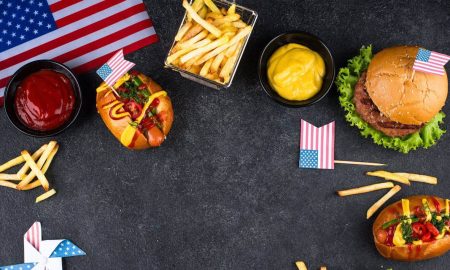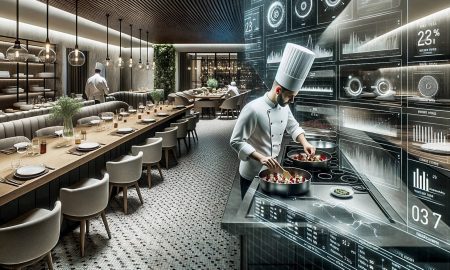We have become accustomed to living in a time of change – so much so that most of us are not even aware of how much gastronomy has changed over the past 20 years. You could go a step further and argue it has changed more in that time frame than in the two centuries prior to that. This is the result of a major transformation process that can be broadly referred to as digitalization, however imprecise and vague that term may be.
Never before have decision-makers in the gastronomy industry had to be more aware and open to new digital processes, nor as hands-on when it comes to rethinking analog workflows and considering digital alternatives instead. But what exactly does that mean? How digital can gastronomy be today, and how digital is it likely to be in the future? Finally, what are the limits to digitalization in gastronomy – a business that ultimately revolves around analog things, namely food, drink and people?

Image: Rational
Digitalization in gastronomy: Tailored solutions for large-scale catering and star restaurants
If you want to take a closer look at the possibilities ofdigitalization in gastronomy, you should always keep three things in mind:
First, the industry is lacking skilled workers workers, in other words, real people made of flesh and blood. To counteract this shortage, digital – that is, solutions that do no require actual humans – are definitely the order of the day.
Second, digitalization is complex and can be implemented in a wide variety of ways and forms, from incoming goods to food sold.
Third, and here it gets a little more complicated: Not every form of gastronomy can handle the same level of digitalization. A three-star restaurant, where most guests want to get to know the personal cuisine of the chef, thrives on the creative search for new flavors that calls for craftsmanship. By contrast, large-scale catering operations, such as company canteens that have to feed 500 employees five days a week, work differently: The focus there is not just on the chef’s creativity. Above all, it is about producing large quantities of food at consistently good quality. The potential of standardized processes, such as the digitalization of gastronomy, therefore takes on a different significance than in the previously mentioned three-star restaurant.
However, as different as these two worlds may be, digitalization offers something that could optimize every type of food service business. Above all, it is important to know the main points where human error is most likely to occur – and where digitalization can be leveraged to enhance a particular gastronomic concept.

Image: Rational
Gastronomy software: The digitalization of gastronomy needs interfaces
Let’s start with the first production step: ordering goods. Over the past 20 years, a wide range of software has conquered the market, saving restaurant owners time and effort. These are often cloud-based systems that link orders and inventory management, helping those responsible to manage food purchases more efficiently. Sometimes they even go so far that they order the required products from the wholesaler’s linked ordering system as soon as they create a new menu.
And it is precisely what Gastronomy 4.0 will be all about more than ever before, in other words: interfaces. After all, these are the tools that will unlock the full potential of digitalization in the gastronomy industry.
Best example: Cloud-based incoming goods control within the HACCP process. As part of Rational’s digital kitchen management system ConnectedCooking, the entire HACCP process can be fully documented in a cloud-based checklist and hygiene management can be adapted to every (new) kitchen process. In this case, digitalization does not just mean that a Bluetooth thermometer records the core temperature of a product during delivery, but also that the required core temperature is stored in the checklist during the cooking process. This is another digitalization process that will play a major role in the future: food production and cooking paths in Rational’s iVario and iCombi cooking systems.

Image: Rational
Networked kitchen appliances as the key to digitizing gastronomy
This is precisely where it becomes clear how relevant the interaction between hardware and software is in food production. Tailored to the user and networked, the cooking systems have a personalized user interface that represents every dish on the menu. The cooking path for the desired dish can be selected at the touch of a button.
What’s special about this? Each chef can also define the exact core temperature or browning level they want in the presets – they specify the result, the rest is done by the intelligent system. The decisive advantage: Since it only takes the push of a button, even unskilled employees can cook any dish safely and with consistent quality.
Wherever technology is ahead of people, digital solutions will continue to gain ground in the years to come. This also applies to tools that address topics such as food waste in gastronomic kitchens. A digital solution for this problem is now available in the form of smart scales, which are specifically designed to measure and reduce food waste in the gastronomy industry. This scale combines weight sensors with artificial intelligence to analyze exactly what and how much food is thrown away. The data gathered helps kitchens minimize waste by making better purchasing and preparation decisions. This brings both environmental and economic benefits. But what does this all mean for the overall gastronomic experience for the guest of the future?

Image: AdobeStock | peopleimages.com
Digital gastronomy increases guest satisfaction
Even today, guests expect a certain degree of digitalization in the gastronomy industry. In most cases, contactless payment methods and mobile wallets are now part of everyday life and enable quick and convenient payments. They provide two major advantages: cashless payment not only simplifies matters for the staff, it also increases guest satisfaction.
Digitalized ordering systems such as orders via app, websites or social media channels have also shown in recent years how useful digitalization can be used in the gastronomy sector. This enables customers to place orders at any time using their preferred channel, without having to search for the right number or worry about opening hours. If all orders are processed through one system, order processing can be optimized for each individual customer. This also allows customer data to be used for targeted meal planning. Everyone benefits from this, including the restaurateur, wholesaler and guests. This allows restaurants and large-scale caterers to optimize their menus, reduce food waste and offer even more tailored services and prices.
What has become increasingly clear in recent years is that digital reservation systems have revolutionized table booking by allowing guests to make reservations anytime, anywhere. This stored guest data can help create personalized experiences and targeted service, which is especially important in high-end restaurants. In addition, it has significantly improved issues with no-shows: During the digital reservation process, guests purchase their “ticket”, which they can usually cancel free of charge up to 24 hours before the date. If they don’t cancel, they usually pay for at least part of the meal. Therefore, the restaurant owner doesn’t have to carry the cost of the guests they plan for but who don’t show up.

Image: Fotolia / Monkey Business
The digitalization of gastronomy and the basic need for analog breaks
However, as mentioned at the beginning, gastronomy from the guest’s perspective has been the same for centuries. This is likely to continue in the future. Robert J.C. Munday, Executive Vice President Marketing & Customer Solutions at Rational, put it as follows: “Eating will remain one of those tangible things that we want to taste, feel, smell and share and experience with others. And that’s exactly why we know: Gastronomy in general and restaurants in particular are in principle something timeless. People will continue to want to eat, drink and enjoy together in specially designed venues. Because it’s simply rooted in a fundamental basic analog human need.”
However, the manner in which this basic analog need is fulfilled is likely to remain unaffected by the digitalization of the gastronomy industry. Sure, in some restaurant concepts waiters could be replaced by humanoid service robots. On the other hand, experts also predict that digital media will triumph in those areas where dedicated flesh-and-blood service staff continue to be in charge: namely, through the use of QR codes. In the digitized gastronomy of the future, they will be everywhere: on every plate, each container, the furniture and even wine bottles. This is good news because they will become a low-threshold medium of interaction between the restaurateur and their guest. And all this with no extra work required for the restaurateur or service staff. Whether it’s the products used in a dish, the vintage of a wine, the supply chain of a particular ingredient, the reason why a particular sparkling wine has been chosen, or the decoration in the dining room: QR codes or their further development will create touchpoints between the restaurant and its guest, which will set new standards.
However, it is also clear that the digitalization behind the scenes will continue to transform gastronomy to a much greater extent than the digitalization in the dining room. This will be for the same reason that has always driven restaurateurs: Namely, to offer guests a relaxing break – also and especially from the ubiquitous digitalization, which can be quite exhausting in times of far-reaching transformations.
















